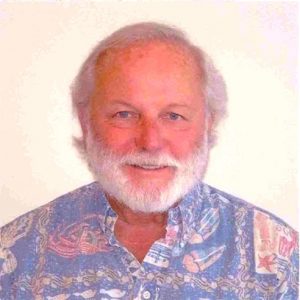Professor Emeritus: Gregor Cailliet

Education:
Ph.D., Biology ‑ University of California, Santa Barbara, 1972
B.A., Analytical Biology ‑ University of California, Santa Barbara, 1966
For an up-to-date listing of Greg's publications, please visit my Google Scholar profile.
I have maintained an active interest in the ecology of Elkhorn Slough and served for 11 years on the Elkhorn Slough National Estuarine Research Reserve (ESNERR) Advisory Committee and its Research Subcommittee. With colleagues and graduate students, I have published several papers on the fish assemblages in the slough and their microhabitat utilization and feeding habits. We have also documented how erosional changes in slough habitats have affected fish ecology there.
I have also been very active in the Monterey Bay National Marine Sanctuary (MBNMS), serving as co-founder of the Research Activity Panel (RAP: a Working Group) and as a founding member of the Sanctuary Advisory Council (SAC) for 9 years. I remain an active member of the RAP and maintain an active interest in the MBNMS. I support and have entered class trawl data into the Sanctuary Integrated Monitoring Network (SIMoN).
My students, colleagues, and I have been actively concentrated on studies of age and growth of fishes. These are important because the results all have fishery management implications. Starting in 1979, the California Sea Grant College Program supported my graduate students and our studies of age and growth of elasmobranch fishes (sharks and rays), sturgeons, and bony fishes like blue marlin, sablefish, rockfishes, and rattails. We have developed age determination and verification techniques which involve observing and counting growth zones in calcified structures like the vertebral centra of elasmobranchs and scutes, fin rays, bones, and otoliths of bony fishes. We have published numerous papers on the age and growth, some with age validation, of many groups and species of marine fishes.
In addition, we have evaluated the temporal periodicity with which these growth zones are deposited by initiating tagging studies, during which we inject live fishes with oxytetracycline (OTC), an antibiotic which concentrates itself in calcifying tissue, and fluoresces under ultra-violet light. This can be used as a temporal mark in the calcified structure and the growth bands can be counted subsequent to this mark and compared to the time at large prior to recapture. Most of this work has involved field-recaptured fishes, such as angel sharks, leopard sharks, and white sturgeon.
Our more recent age validation research involves radiometric age verification of otoliths from deep-water rockfishes and rattails, in collaboration with Dr. Kenneth Coale, former MLML Director and Chemical Oceanographer, and former Research Affiliate Dr. Allen Andrews (now with the National Marine Fisheries Service in Hawaii). This technique involves analyzing cores of otoliths for Pb-210 and Ra-226, ultimately producing Pb-210:Ra-226 disequilibria, which, based upon their respective half-lives, provide independent estimates of age. We applied this technique to many species of fishes, including chondrichthyans, and deep-sea corals, worldwide, including fishes from the southern hemisphere such as the orange roughy, oreos, and Antarctic and Patagonian toothfishes, the latter two supported by the National Science Foundation.
Another of our former graduate students, Dr. Lisa Kerr (presently at the Gulf of Maine Research Institute), started analyzing bomb-generated radiocarbon in the otoliths of two species, the yelloweye (Sebastes ruberrimus), and quillback (S. maliger) rockfishes, both of which have high longevities, the first of which exceeds 120 years. We also analyzed vertebrae of white sharks (Carcharodon carcharias) and shortfin mako sharks (Isurus oxyrinchus) for bomb radiocarbon and obtained validated growth characteristics and longevity estimates.
We have also continued to work on other ecological aspects of California marine fishes. We have done studies on the larval growth, development, and age and growth of rockfishes, genus Sebastes. In addition, we have studied the dispersal of larval and juvenile rockfishes, relative to sea surface features and upwelling plumes. We completed a study on the life history of hagfishes in Monterey Bay, relative to fishing pressure that was being exerted on their local populations. We analyzed their microhabitat utilization patterns, using videos taken by the Monterey Bay Aquarium Research Institute’s ROV (“Ventana”).
In collaboration with Mexican government and academic scientists, and biologists at Mote Marine Laboratories in Florida, former graduate students Drs. Wade Smith, Joe Bizzarro and I completed field surveys of the shark and ray fishing camps in the Gulf of California and Baja California Peninsula. We also did life history studies of selected shark and ray species identified during these surveys. We established a database from which to build upon in future fisheries monitoring, management, and conservation efforts.
In 2002, we started receiving Congressional funding to support our fishery-related research on sharks, rays and chimaeras of the eastern North Pacific. Former MLML graduate student, Dr. David Ebert, is the Program Manager of our center (the Pacific Shark Research Center or PSRC) in the National Shark Research Consortium (NSRC) comprised of scientists at Mote Marine Laboratory, the University of Florida, and the Virginia Institute of Marine Sciences. For further information on the activities of PSRC, please go to: http://psrc.mlml.calstate.edu/.
Although I officially retired in July, 2009, I still maintain an active interest in the above research and continue to act as the Program Director Emeritus of the PSRC, in addition to serving as Professor Emeritus at MLML and California State University, Fresno.

